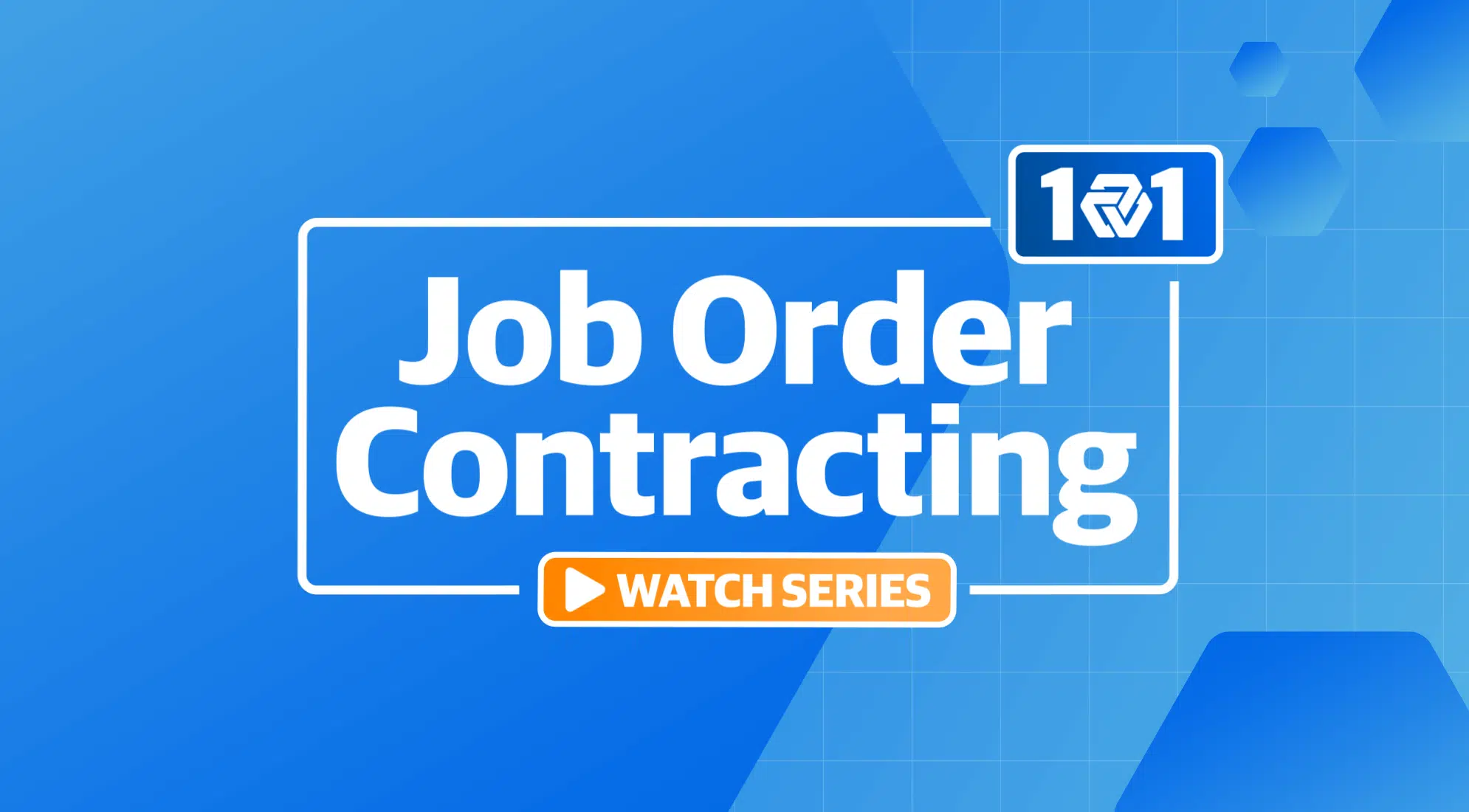Learn what is Job Order Contracting from the 2024 Job Order Contracting (JOC) Basics Series, which will provide a thorough introduction to this project delivery method. Topics in this series include benefits of JOC for contractors, facilities leaders, procurement leaders and local communities. We’ll also cover options for accessing a Job Order Contract, what makes an ideal JOC project and how to find a best-in-class Job Order Contracting provider.
Defining Job Order Contracting
Job Order Contracting (or JOC) is defined as an Indefinite Delivery, Indefinite Quantity (IDIQ) construction project delivery method. Put simply, this means that one construction contract can be used at various times to complete one or multiple projects.
Instead of preparing separate bid documents and enduring the time-consuming process of putting every individual construction project out to bid, JOC empowers owners to complete many projects with one competitively-awarded contract. These contracts satisfy local procurement statutes and establish prices for construction tasks up front, ensuring owners maintain budget control.
What Are the Benefits of Job Order Contracting?
Job Order Contracting (JOC) offers several notable benefits for construction project management, including:
- Increased Efficiency in Project Delivery: Job Order Contracting allows multiple projects to be completed under a single, multi-year contract, significantly reducing administrative costs and the time associated with bidding for each individual project.
- Collaborative Relationships: This contracting method fosters better relationships between contractors and clients through the use of pre-priced construction tasks and clear performance terms, which lead to fewer disputes and improved project quality.
- Cost Transparency and Control: JOC offers greater cost transparency and control, facilitating more predictable budgeting and financial planning for organizations.
Find out more about how you can accelerate the construction projects that matter most.
Basic Steps of a JOC Program
Here’s a simplified overview showing how a standard JOC program works (in this example, from the perspective of a municipal government organization):
Launch the Bidding Process
A city government announces a Job Order Contract (JOC) by inviting bids from contractors. These contractors must submit their bids, indicating their Adjustment Factor based on a range of expected tasks from maintenance to comprehensive upgrades.
Establish the Master Agreement
Once the bids are assessed, the city selects a contractor, typically the one with the most economical proposal, and establishes a master agreement. This agreement specifies the maximum timeline and budget for the project, facilitating multiple sub-projects under these constraints.
Identify Necessary Projects
City officials and the selected general contractor work together to identify necessary infrastructure projects. Initial assessments might point to various needs such as street repairs, public building renovations or park improvements.
Develop Task Orders
The general contractor drafts individual task orders, calculating costs based on the discussed details during the scope meetings and referencing the Unit Price Book (UPB). These costs are derived by multiplying the amount of work by UPB rates and the contractor’s adjustment factor.
Procure Subcontractor Bids
In parallel, the general contractor solicits bids from subcontractors crucial for carrying out the task orders, ensuring that the pre-established unit prices are viable.
Finalize Proposals and Scheduling
The contractor submits detailed proposals, including task order costs and timelines, to the city for approval. Once approved, the contractor can proceed with subcontracting specialty tasks and ordering necessary materials.
Manage and Close Projects
The contractor meticulously oversees all task orders to ensure timely completion, employing a consistent system for task identification and numbering, like using specific project codes (e.g., 2001 for streets, 2001.01 for specific repairs).
This approach demonstrates how Job Order Contracting serves as an effective project management and procurement method for city governments, ensuring organized, transparent and timely completion of public works.
Who Should Use Job Order Contracting?
Job Order Contracting is particularly beneficial for entities that manage multiple construction projects or frequent facility renovations. This includes:
- Public Sector Organizations: Including municipalities, states and federal agencies, which often need to expedite a large number of projects.
- Educational Institutions: Schools, universities and colleges can use JOC to handle routine maintenance and renovations with minimal disruption to academic schedules.
- Healthcare Facilities: Hospitals and other healthcare providers benefit from JOC’s efficiency for ongoing infrastructure upgrades and expansions.
- Transportation Authorities: Useful for managing recurring maintenance and upgrades of transportation infrastructure like airports and transit systems.
These organizations can leverage JOC to achieve faster project turnaround, controlled costs and reduced administrative overhead.
Want to find out more about how a best-in-class JOC program works? Watch the Job Order Contracting 101 video series.







